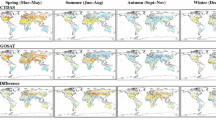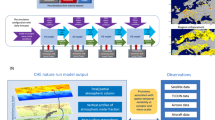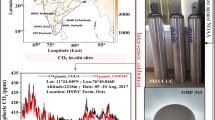Abstract
Carbon dioxide (CO2) and methane (CH4) are important atmospheric greenhouse gases (GHG) and, therefore, classified as essential climate variables (ECVs). Previously, satellite-derived atmospheric CO2 and methane CH4 ECV data sets have been generated and made available via the GHG-CCI project of the European Space Agency’s (ESA) Climate Change Initiative (CCI, http://www.esa-ghg-cci.org/). The latest GHG-CCI data set, Climate Research Data Package No. 4 (CRDP 4), covers the time period 2003–2015 and is available since February 2017. Currently, the production and provision of these data sets is being continued (pre-)operationally via the Copernicus Climate Change Service (C3S, https://climate.copernicus.eu/), which is implemented by the European Centre for Medium-Range Weather Forecasts (ECMWF) on behalf of the European Commission. The C3S satellite GHG sub-project (C3S_312a_Lot6) is led by University of Bremen supported by University of Leicester (UK), SRON (The Netherlands) and CNRS-LMD (France). The first Climate Data Record (CDR) data set produced and delivered within the C3S framework covers the time period 2003–2016 and consists of column-average dry-air mole fraction CO2 and CH4 products, i.e., XCO2 and XCH4, from SCIAMACHY/ENVISAT and TANSO-FTS/GOSAT. Furthermore, mid-tropospheric CO2 and CH4 mixing ratios from IASI Metop-A and Metop-B are part of this data set. It is planned to extend this data set each year by one additional year. The data products are available via the Climate Data Store (CDS) of C3S. Here a short overview about this new Earth Observation data set is presented.
Similar content being viewed by others
Avoid common mistakes on your manuscript.
1 Introduction
Increasing concentrations of atmospheric carbon dioxide (CO2) result in global warming with adverse consequences such as global sea level rise [1]. Despite its importance, our knowledge concerning the various natural and anthropogenic sources and sinks of this greenhouse gas (GHG) has significant gaps. Global satellite observations of CO2 in combination with (inverse) modelling helps to obtain a better understanding of the CO2 sources and sinks (e.g., [2] and references given therein). This requires satellite observations, which are sensitive to CO2 concentration changes close to the Earth’s surface as can be obtained from radiance measurements in the short-wave-infrared (SWIR) spectral range, which permit to retrieve column-average dry-air mole fractions of CO2, denoted XCO2, shown in Fig. 1.
Figure 1 shows global maps of XCO2 for selected months in the time period beginning of 2003 to end of 2016 as generated for the Copernicus Climate Change Service (C3S) and available via the C3S website [3]. Also shown are XCO2 time series for three latitude bands: northern mid-latitudes (red), tropics (green) and southern mid-latitudes (blue). As can be seen, all time series show an increasing trend primarily due to burning of fossil fuels. As can also be seen, CO2 varies significantly within each year (especially over the northern hemisphere) due to quasi-regular seasonal uptake and release of atmospheric CO2 by the terrestrial biosphere (photosynthesis, respiration, decay of organic matter). Fortunately, land and ocean sinks currently take up about half of the emitted CO2 [4]. Without these natural sinks the atmospheric increase would be approximately twice as high. However, our knowledge about these important natural CO2 sinks is currently not appropriate for reliable climate prediction as we currently do not know well enough how these natural sinks will respond to a changing climate [1]. Satellite observations such as the ones shown in Fig. 1 are used to obtain a better understanding of the CO2 sources and sinks (e.g., [2] and references given therein).
Atmospheric methane (CH4) is also an important greenhouse gas with many natural and anthropogenic sources [1]. Satellite radiance measurements in the SWIR spectral region are also sensitive to near-surface CH4 concentration variations and therefore permit to retrieve column-average dry-air mole fractions of CH4, denoted XCH4, shown in Fig. 2. Atmospheric methane increased by about 150% since pre-industrial times, but concentrations were nearly constant since the late 1990s. However, since 2007 CH4 concentrations started to increase again (Fig. 2). The identification of the reason for this is currently undergoing scientific research (e.g., [5, 6] and references given therein).
In the following, a short overview about this new data set is presented.
2 C3S Satellite-Derived CO2 and CH4 Data Set
2.1 Overview
The C3S satellite-derived CO2 and CH4 data set has been generated by applying dedicated retrieval algorithms (e.g., [2, 7] and references given therein) to the satellite radiance measurements in order to obtain individual satellite-sensor Level 2 data products, which provide atmospheric CO2 and/or CH4 information for individual satellite footprints (ground pixel). These data products contain for each satellite footprint in addition to information on CO2 and CH4 (and corresponding uncertainty estimates) also a number of other important quantities such as exact location and time of each observation, used a priori information (e.g., a priori profiles) and information on the altitude sensitivity of the retrievals (averaging kernels) [7].
As described in more detail below, these fundamental individual-sensor Level 2 data products are (depending on product type) merged to generate higher-level data products (“merged Level 2” and “merged Level 3” products).
The current C3S CO2 and CH4 data set has been generated using these satellite instruments (see [2, 7] and references given therein):
-
SCIAMACHY on ENVISAT (2002–2012) and TANSO-FTS/GOSAT (since mid 2009) for the XCO2 and XCH4 data products (see Figs. 1, 2)
-
IASI on Metop-A and Metop-B for CO2 and CH4 mid-tropospheric mixing ratios and AIRS for mid-tropospheric CO2.
The current (and first) C3S data set covers the years 2003–2016. It is planned to add each year one additional year. This may include re-processing of entire individual-sensor time series if improved retrieval algorithms are available; the merged products will always be based on re-processing for each new data set. The next data set will cover the time period 2003–2017 and will be available end of 2018 including documentation (updated user guide, algorithm descriptions, initial data quality documentation, etc.).
2.2 Requirements
Requirements for satellite-derived essential climate variable (ECV) data products have been formulate by Global Climate Observing System (GCOS) [9] and these requirements have been considered for the generation of the data products described here and for the corresponding User Requirements Document (URD) of the GHG-CCI pre-cursor project (available from [10]) and for the corresponding C3S Target Requirements Document (TRD) (available from [3]).
The most challenging requirement is the accuracy or bias requirement for XCO2, where a relative accuracy of better than 0.5 ppm (approx. 0.1%) is required. The reason for this demanding requirement is that even very small errors can result in large regional-scale CO2 surface flux errors depending on the spatio-temporal structure of the XCO2 biases.
2.3 Data Products
The C3S satellite-derived CO2 and CH4 data set consists of three types of data products (see [7] for details):
-
1.
Individual-sensor Level 2 (L2) products: XCO2, XCH4 and mid-tropospheric CO2 and CH4 information for individual footprints of individual satellites as generated using dedicated retrieval algorithms
-
2.
Merged L2 products: a single XCO2 and a single XCH4 product covering the entire time period (currently 2003–2016) generated by merging individual sensor L2 products [including GOSAT products from National Aeronautics and Space Administration (NASA) and Japan’s National Institute for Environmental Studies (NIES)] using the Ensemble Median Algorithm (EMMA) [11]
-
3.
Merged Level 3 (L3) products: gridded monthly XCO2 and XCH4 products (at 5° × 5° spatial resolution) in Obs4MIPs format (see [7]) as generated from the merged L2 products (see Figs. 1, 2).
The products are listed in Table 1. Each individual product has a product ID indicating if it is a CO2 or CH4 product, the corresponding satellite (SCI = SCIAMACHY, GOS = GOSAT, IASA/IASB = IASI Metop-A or B, AIR = AIRS) and the used retrieval algorithm.
2.4 Data Quality
The data quality of the XCO2 and XCH4 data products has been estimated by comparisons with the corresponding ground-based data products of the Total Carbon Column Observing Network (TCCON) [12]. The overall L2 products comparison results are shown in Fig. 3 for the XCO2 and in Fig. 4 for XCH4. As can be seen, the single footprint random error is about 2 ppm for XCO2 and 50–90 ppb for SCIAMACHY XCH4 and around 20 ppb for GOSAT XCH4. The relative accuracy is around 0.5 ppm for XCO2 and around 10 ppb for SCIAMACHY XCH4 and around 5 ppb for GOSAT XCH4. Stability in terms of linear bias drift is high for all products.
Data quality overview XCO2 L2 products. From top to bottom: random error, relative accuracy, probability that relative accuracy is < 0.5 ppm, stability, probability that stability is < 0.5 ppm/year. From [8]
Data quality overview XCH4 L2 products. From top to bottom: random error, relative accuracy, probability that relative accuracy is < 10 ppb, stability, probability that stability is < 3 ppb/year. From [8]
The IASI and AIRS mid-tropospheric products have been compared with aircraft observations [8] and it has been estimated that the single footprint random errors are around 1 ppm for IASI CO2, around 1.3 ppb for AIRS CO2 and 12 ppb for CH4. Relative accuracy is approx. 0.5 ppm for IASI CO2 and around 5 ppb for IASI CH4.
3 Summary and Conclusions
An overview about a new data set of satellite-derived CO2 and CH4 data products relevant for carbon and climate related research has been presented.
The data products have been generated in the framework of the Copernicus Climate Change Service (C3S) and they are publicly and free-of-charge available for interested users including documentation via the Copernicus Climate Data Store (CDS) accessible via the C3S website [3].
Currently, the data set covers the time period 2003–2016, but it is planned to extend it each year by year one additional year. The next data set will cover the time period 2003–2017 and will be available end of 2018.
References
IPCC (2013) Climate change 2013: the physical science basis, Working Group I contribution to the fifth assessment report of the intergovernmental report on climate change. Cambridge University Press, Cambridge
Buchwitz M, Reuter M, Schneising O et al (2017) Global satellite observations of column-averaged carbon dioxide and methane: the GHG-CCI XCO2 and XCH4 CRDP3 data set. Remote Sens Environ 203:276–295
C3S website (https://climate.copernicus.eu/) including Climate Data Store (CDS, https://cds.climate.copernicus.eu)
Le Quéré C, Andrew RM, Friedlingstein P et al (2018) Global carbon budget 2017. Earth Syst Sci Data 10:405–448. https://doi.org/10.5194/essd-10-405-2018
Houweling S, Krol M, Bergamaschi P et al (2014) A multi-year methane inversion using SCIAMACHY, accounting for systematic errors using TCCON measurements. Atmos Chem Phys 14:3991–4012
Worden JR, Bloom AA, Pandey S et al (2017) Reduced biomass burning emissions reconcile conflicting estimates of the post-2006 atmospheric methane budget. Nat Commun. https://doi.org/10.1038/s41467-017-02246-0
Buchwitz M, Reuter M, Schneising-Weigel O et al (2017) Product user guide and specification (PUGS)—main document. Technical report Copernicus Climate Change Service (C3S). C3S website https://climate.copernicus.eu/. 20 Oct 2017, p 91
Buchwitz M, Reuter M, Schneising-Weigel O et al (2017) Product quality assessment report (PQAR)—main document. Technical report Copernicus Climate Change Service (C3S), available from C3S website https://climate.copernicus.eu/. 20 Oct 2017, p 103
Global Climate Observing System (GCOS) (2016) The global observing system for climate: implementation needs. World Meteorological Organization (WMO), GCOS-200 (GOOS-214), Geneva, p 325
GHG-CCI website. http://www.esa-ghg-cci.org/
Reuter M, Boesch H, Bovensmann H et al (2013) A joint effort to deliver satellite retrieved atmospheric CO2 concentrations for surface flux inversions: the ensemble median algorithm EMMA. Atmos Chem Phys 13:1771–1780
Wunch D, Toon GC, Blavier J-FL et al (2011) The total carbon column observing network. Philos Trans R Soc A 369:2087–2112
Acknowledgements
This study has been funded in parts by the European Space Agency (ESA) (via the GHG-CCI project of ESA’s Climate Change Initiative (CCI, http://www.esa-ghg-cci.org/)), by the Copernicus Climate Change Service (C3S) implemented by the European Centre for Medium-Range Weather Forecasts (ECMWF) on behalf of the European Commission (https://climate.copernicus.eu/) and by the State and the University of Bremen. The University of Leicester GOSAT retrievals used the ALICE High Performance Computing Facility at the University of Leicester. We thank ESA/DLR for providing us with SCIAMACHY Level 1 data products and JAXA for GOSAT Level 1B data. We also thank ESA for making these GOSAT products available via the ESA Third Party Mission archive. We thank NIES for the operational GOSAT XCO2 Level 2 product and the NASA/ACOS team for the GOSAT ACOS Level 2 XCO2 product. We also thank the TCCON team for making available the ground-based TCCON retrievals used for validation of the satellite data products (http://www.tccon.caltech.edu/).
Author information
Authors and Affiliations
Corresponding author
Rights and permissions
Open Access This article is distributed under the terms of the Creative Commons Attribution 4.0 International License (http://creativecommons.org/licenses/by/4.0/), which permits unrestricted use, distribution, and reproduction in any medium, provided you give appropriate credit to the original author(s) and the source, provide a link to the Creative Commons license, and indicate if changes were made.
About this article
Cite this article
Buchwitz, M., Reuter, M., Schneising, O. et al. Copernicus Climate Change Service (C3S) Global Satellite Observations of Atmospheric Carbon Dioxide and Methane. Adv. Astronaut. Sci. Technol. 1, 57–60 (2018). https://doi.org/10.1007/s42423-018-0004-6
Received:
Revised:
Accepted:
Published:
Issue Date:
DOI: https://doi.org/10.1007/s42423-018-0004-6








